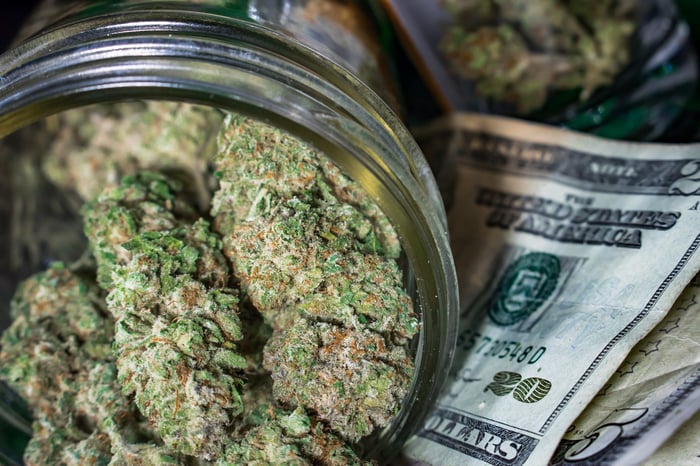The marijuana industry is on fire, and marijuana stocks certainly tell the tale. In many instances, the largest marijuana stocks (those with market caps in excess of $200 million) have vaulted higher by 100%, 200%, or even more, over the trailing 12 months.
Hashing out why pot stocks are soaring
There's a lot for investors to be excited about. For instance, the percentage of people who want to see cannabis legalized across the United States has more than doubled from 25% to 60% between 1995 and 2016, per Gallup. Growing acceptance and favorability toward recreational pot (favorability toward medical marijuana is even higher) has investors high on the hope that lawmakers will listen to their constituents and call for change on Capitol Hill.

Image source: Getty Images.
Investors also have to be loving the many pathways of expansion we're witnessing in North America. Last month, Mexican President Enrique Pena Nieto signed into a law a bill that legalized medical cannabis. Pena Nieto had, at one time, been an ardent opponent of medical cannabis, but he's changed his tune and been a proponent for medical weed access for the past couple of years. Likewise, a bill is working its way through the Canadian parliament that could see our neighbors to the north legalize recreational marijuana by as soon as July 1, 2018. This all comes on top of residents in eight U.S. states voting to legalize recreational weed since Nov. 2012.
And, of course, there are the legal sales figures. Colorado, one of the first two states to have legalized recreational pot, generated more than $1.3 billion in combined recreational and medical weed last year, a better than 30% year-over-year improvement. In terms of North American sales, cannabis research firm ArcView estimates $6.9 billion was sold legally in 2016, a 34% increase from the previous year. ArcView projects that the legal industry's annual growth rate through 2021 should be a healthy 26%.
You add these catalysts up, and we have a very bullish outlook for pot stocks.
Aphria's profit streak goes up in smoke
Perhaps the one thing that's held marijuana stocks back, though, is their lack of profits. Keeping in mind that marijuana is still a wholly illicit substance at the federal level in the U.S., and is an illicit substance in recreational form in Canada and Mexico for the time being, most marijuana stocks are cranking out losses, quarter after quarter.

Image source: Getty Images.
However, one pretty consistent exception to the rule has been Canadian medical cannabis producer and retailer Aphria (NASDAQOTH: APHQF). Heading into the company's fourth-quarter report, the company had generated five consecutive quarterly profits. Admittedly, these were nominally small profits relative to its hefty valuation, but it nevertheless allowed Aphria to stand out from its competition. On Wednesday, July 12, Aphria delivered its much-anticipated fourth-quarter results.
What stood out? Surprisingly, the first thing I noticed wasn't its exceptional sales growth or its cost reductions, but the $2.04 million quarterly loss it reported, ending its five-quarter string of profits. Why the loss? According to the press release, $5.5 million in strategic investments was the culprit. These investments include its efforts to boost capacity expansion. But in spite of its quarterly loss, the company still managed to turn a full-year profit of $3.3 million, which was a 955% improvement from the prior-year period.
This was a great quarter, loss aside
However, if you can look past the fact that Aphria's profit streak went up in smoke at five quarters, there's a laundry list of items to be pleased with. For example, EBITDA was positive for the seventh straight quarter, and it grew 962% on a year-over-year basis. The company's adjusted gross margin also improved 670 basis points to 77.6% for fiscal 2017. And how can we forget a 142% increase in full-year sales to north of $16 million.

Image source: Getty Images.
But the really juicy updates relate to the company's capacity expectations and its ongoing costs to produce cannabis.
According to the report, Aphria increased its annual production expectations from Part II, Part III, and Part IV of its capacity expansion to 9,000 kilograms (kgs) of cannabis, 30,000 kgs, and 100,000 kgs, respectively, As of the sequential third quarter, the projected yield of these expansions was 8,000 kgs, 22,000 kgs, and 75,000 kgs, respectively. This is particularly noteworthy given the consideration Canada is giving to legalizing recreational weed. Aphria has already benefited from Canada's rapidly growing medical cannabis user base, and is among a select few companies that's able to export cannabis to medical marijuana-legal countries. If its domestic market tacked on recreational pot as legal, too, demand could go through the roof.
The company's efforts to improve its growing efficiency are helping as well. The company's all-in cash costs fell in the fourth quarter to $1.31 a gram ($1.67 Canadian), which is a 25% drop from the sequential third quarter. Its cash costs to produce dried cannabis fell an even more impressive 36% from Q3 2017. All the while, its percentage of cannabis oil sales as a function of total revenue grew once more to 32% of total sales in Q4 2017. This is important because cannabis oils often command better pricing power and higher margins for growers.
In other words, with the exception of the disappointment from Aphria's quarterly profit streak ending, this was actually a great quarter for the company.

Image source: Getty Images.
But there's still a big problem
In many ways, Aphria stands head and shoulders above most of its peers. Its capital projects are fully funded, and it's been profitable for far more quarters than it hasn't over the past two years. Plus, it benefits from being one of the few growers that's legally allowed to export its product.
However, there's still a big problem that should cause investors to pause before considering a company like Aphria: its valuation. Aphria ended July 13 with a valuation of $579 million. Comparatively, as noted above, it generated a profit of just $3.3 million, which only works out to around $0.027 in annual EPS (and I'm rounding up). This means the company is valued at a P/E for fiscal 2017 of 165! Yikes!
Yes, investors are probably (and rightly) factoring in the potential for a recreational expansion in Canada, and future export and medical industry growth. Nevertheless, they're ignoring possible political concerns if Canada doesn't move forward as planned. Let's not forget that Prime Minister Trudeau has wanted to legalize recreational pot for years, but has thus far been unable to do so.
These same investors are also overlooking a very frothy valuation, even among one of the best marijuana stocks from a full-year profitability perspective.
Despite a very encouraging quarter, investors are best off monitoring Aphria from the sidelines until we get a better sense of what's next in Canada for recreational weed.



